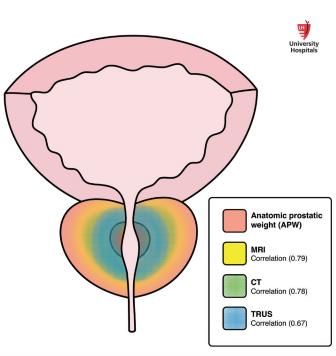Objective: To evaluate the accuracy of transrectal ultrasound (TRUS), computed tomography (CT), and magnetic resonance imaging (MRI) compared to the reference standard of the post-surgical anatomic prostatic weight (APW).
Material and methods: A total of 349 patients from two institutions were included. The CT and MRI dimensions, and TRUS-reported prostate volumes (PV) were obtained. The prolate ellipsoid formula was used to calculate PV. Cross-sectional measurements were evaluated and compared to the reported post-surgical pathology measurements and calculated pathology volume (path PV). A basic statistical analysis was performed using the Pearson correlation, Bland–Altman analysis, and Passing–Bablok regression.
Results: A total of 198 patients were included in the MRI group, 118 in the CT group, 295 in the TRUS group, and 51 in the all-inclusive common cohort. The MRI PV demonstrated a good to excellent correlation with the APW (r=0.79). The CT PV demonstrated a good correlation with APW (r=0.78). The TRUS PV showed a correlation with APW (r=0.67). The correlations identified in each individual group held true in the common cohort as well. The path PV showed an excellent correlation with APW (r=0.87), followed by MRI PV (r=0.81), then CT PV (r=0.73), and lastly TRUS PV (r=0.71).
Conclusion: MRI and CT are equally effective in assessing the PV, and they can be readily utilized to guide the benign prostatic hyperplasia (BPH) management without repeating in-office TRUS. This is not only cost-effective, but also eliminates patient anxiety and discomfort.
Cite this article as: Narayanamurthy V, Mishra K, Mahran A, Bukavina L, Ponsky L, Gnessin E. Inter-imaging accuracy of computed tomography, magnetic resonance imaging, and transrectal ultrasound in measuring prostate volume compared to the anatomic prostatic weight. Turk J Urol 2020; 46(1): 50-6.

.png)


.png)
